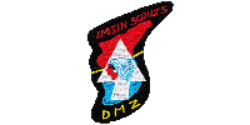



U.S. to stop patrols after 50 years, give more duties to S. Koreans
By Jeremy Kirk, Stars and Stripes
Pacific edition, Tuesday, April 13, 2004
PANMUNJOM, Korea - From a United Nations conference building along the Koreas' border, Spc. Craig Lau and Pvt. Jorge Fernandez looked out a window at two North Korean soldiers just a few feet away.
For U.S. and North Korean soldiers to be so close is relatively uncommon but the two U.S. soldiers' job, guiding tours in the Joint Security Area, sometimes puts them in such proximity. It's not tense; everyone looks a bit bored - another day on the job on what's termed the world's most dangerous border.
But many American faces soon will disappear from this front line under a plan to give the South Korean military more leverage over its own defense. Already, just a handful of U.S. soldiers still put on camouflage face paint, load live rounds into rifles and take positions within eyesight - and gunshot range - of North Korean soldiers. But later this year, no U.S. troops will patrol the Demilitarized Zone.
Outpost Ouellette, the last U.S.-staffed outpost - it's about 75 feet from North Korea's border - also will be relinquished. The most strategic spot along the DMZ, it commands a panoramic view of barren North Korean hillsides and, on a clear day, Kaesong - closest North Korean city and site of a joint North-South Korean industrial complex.
The missions will be turned over as part of a reorganization of U.S. forces in South Korea, including returning smaller bases to the South Korean government. It marks U.S. forces' gradual pullback from the DMZ, a move partly inspired by high-tech, long-range weapons that make distance less important during a fight, U.S. officials have said.
It's also a nod to the South Korean military's increased ability, U.S. Forces Korea commander Gen. Leon J. LaPorte told Congress recently. A small U.S. contingent will remain as part of the U.N. Command's Joint Security Battalion, with a U.S. officer in charge, he said.
U.S. Forces Korea could provide no time line for the duty transfer.
The current battalion - 60 percent South Korean, 40 percent American - posts guards in the Joint Security Area - tall South Korean soldiers wearing mirrored sunglasses and standing in modified tae kwon do (martial arts) stances.
As Lau told a tourist last week, the sunglasses hide guards' eye movements. North Korean soldiers who don't wear them, he contended, look undisciplined when their eyes move.
The U.N. Command is a U.S.-led, 15-nation consortium which monitors the Armistice Agreement that ended Korean War fighting in July 1953. The DMZ may appear tranquil but the command investigated 22 armistice infractions over the past year and reported 13 major violations, LaPorte said. Those incidents have included firing weapons and illegal crossings of the Military Demarcation Line, the official border that splits the DMZ, he said.
In July 2003, North and South Korean troops exchanged fire between guard posts. But no Americans have been injured for years, officials said. Since the war's end, though, at least 89 Americans have died from ambushes, downed aircraft, land mines and other actions, military records show.
Those deaths peaked in the late 1960s but the incidents at that time often went unremarked because dozens of Americans then were dying weekly in Vietnam, said William Hollinger, an operations officer with 7th Infantry Division in Korea in 1968-69. As he wrote in his book, "The Fence Walker": "If we're killed on a patrol or a guard post, crushed in a jeep accident or shot by a nervous GI on the fence, no one will ever write about us in the Times or erect a monument or read a Gettysburg Address over our graves. There's too much going on elsewhere; what we're doing is trivial in comparison. We'll never be part of the national memory." Hollinger wrote that the DMZ then was a wasteland of artillery craters, barbed wire, minefields, graveyards and skeletons of villages. U.S. and South Korean forces recorded hundreds of nighttime firefights with North Koreans.
In 1967 and 1968, with U.S. attention on Vietnam, North Korea waged an aggressive campaign of infiltration and provocations against South Korea, according to both military records and soldiers' recollections.
For instance, Don M. Lopez was a 20-year-old private when he served as an infantryman with 2nd Battalion, 9th Infantry Regiment along the DMZ in 1969. "We'd get shot at occasionally. They weren't pitched battles or any serious firefights but they'd snipe at us," said Lopez, a software engineer now living in Pocatello, Idaho.
Lopez runs www.imjinscout.com, a site with photos and recollections of U.S. soldiers who worked along the DMZ when 2nd Infantry Division troops wore an "Imjin Scouts - DMZ" patch.
Lopez said DMZ duty generally was unpleasant: nights in foxholes with sleepy GIs as North Koreans cut the fence lines to infiltrate the south. He remembers North Korean propaganda blared over loudspeakers, such as, "GI go home before we slit your throat!"
By 1971, the U.S. had transferred jurisdiction of an 18.5-mile sector of the DMZ from the 2nd Infantry Division to the 1st Republic of Korea Army Division. A month later, the 7th ID - around 18,000 troops - was pulled out of South Korea after 24 years of service.
In 1991, the U.S. military relinquished its last full sector of the DMZ. Now it only conducts patrols around Tae Sung Dong, the DMZ's only inhabited village, and Outpost Ouellette.
If conflict were to erupt, officials have said, the U.N. Command - led by LaPorte - would head an international force working with the Combined Forces Command, the U.S.-South Korean integrated war-fighting headquarters also led by LaPorte.
"Today the members of the United Nations Command coalition in Korea remain vigilant in an uneasy peace," LaPorte said.
